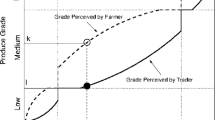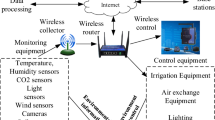Abstract
We develop and implement a model for a profit maximizing firm that provides an intermediation service between commodity producers and commodity end-users. We are motivated by the grain intermediation business at Los Grobo—one of the largest commodity-trading firms in South America. Producers and end-users are distributed over a realistic spatial network, and trade with the firm through contracts for delivery of grain during the marketing season. The firm owns spatially distributed storage facilities, and begins the marketing season with a portfolio of prearranged purchase and sale contracts with upstream and downstream counterparts. The firm aims to maximize profits while satisfying all previous commitments, possibly through the execution of new transactions. Under realistic constraints for capacities, network structure and shipping costs, we identify the optimal trading, storing and shipping policy for the firm as the solution of a profit-maximizing optimization problem, encoded as a minimum cost flow problem in a time-expanded network that captures both geography and time. We perform extensive numerical examples and show significant efficiency gains derived from the joint planning of logistics and trading.



Similar content being viewed by others
Notes
For information about the group please refer to www.losgrobo.com.
ARS means Argentinean Pesos. In the second half of 2013, one Argentine peso was roughly equivalent to 0.20 US dollars
The data presented here have been distorted to preserve confidentiality.
Confederación Argentina del Transporte Automotor de Cargas. See www.catac.org.ar for details.
References
Ahuja RK, Magnanti TL and Orlin JB (1993). Network Flows: Theory, Algorithms, and Applications. Prentice Hall: Upper Saddle River, NJ.
Ahumada O and Villalobos JR (2009). Application of planning models in the agri-food supply chain: A review. European Journal of Operational Research 196 (1): 1–20.
Ahumada O and Villalobos JR (2011). Operational model for planning the harvest and distribution of perishable agricultural products. International Journal of Production Economics 133 (2): 677–687.
Bell DE and Scott C (2010). Los Grobo: Farming’s future?, Harvard Business School General Management Unit Case, 9-511-088.
Bellman R (1956). On the theory of dynamic programming—A warehousing problem. Management Science 2 (3): 272–275.
Boyabatlı O (2015). Supply management in multiproduct firms with fixed proportions technology. Management Science. http://dx.doi.org/10.1287/mnsc.2014.2055.
Boyabatlı O, Kleindorfer PR and Koontz SR (2011). Long-term versus short-term contracting in beef supply chains. Management Science 57 (10): 1771–1787.
Cahn AS (1948). The warehouse problem. Bulletin of the American Mathematical Society 54 (11): 1073.
Charnes A, Dreze J and Miller M (1966). Decision and horizon rules for stochastic planning problems: A linear example. Econometrica 34 (2): 307–330.
Devalkar SK, Anupindi R and Sinha A (2011). Integrated optimization of commodity operations. Operations Research 59 (6): 1369–1381.
Dong L, Kouvelis P and Wu X (2014). The value of operational flexibility in the presence of input and output price uncertainties with oil refining applications. Management Science 60 (12): 2908–2926.
Dreyfus SE (1957). An analytic solution of the warehouse problem. Management Science 4 (1): 99–104.
Geman H (2009). Commodities and Commodity Derivatives: Modeling and Pricing for Agriculturals, Metals and Energy. Wiley: West Sussex, UK.
Glen JJ (1987). Mathematical models in farm planning: A survey. Operations Research 35 (5): 641–666.
Goel A and Gutierrez GJ (2011). Multiechelon procurement and distribution policies for traded commodities. Management Science 57 (12): 2228–2244.
Heady EO (1954). Simplified presentation and logical aspects of linear programming technique. Journal of Farm Economics 24 (5): 1035–1048.
Jones PC, Kegler G, Lowe TJ and Traub RD (2003). Managing the seed-corn supply chain at Syngenta. Interfaces 33 (1): 80–90.
Kazaz B and Webster S (2011). The impact of yield-dependent trading costs. Manufacturing & Service Operations Management 13 (3): 404–417.
Lowe TJ and Preckel PV (2006). Decision technologies for agribusiness problems: A brief review of selected literature and a call for research. Manufacturing & Service Operations Management 6 (3): 201–208.
Martínez de Albéniz V and Simón JMV (2008). A capacitated commodity trading model with market power. Working Paper 728, IESE Business School, University of Navarra, Barcelona, Spain.
Regunaga M (2010). Implications of the organization of the commodity production and processing industry: The soybean chain in Argentina. Case Studies in Latin America and the Caribbean Region. World Bank, Washington, DC.
Secomandi N (2010). Optimal commodity trading with a capacitated storage asset. Management Science 56 (3): 449–467.
Symonds GH (1955). Linear Programming: The Solution of Refinery Problems. Esso Standard Oil Company: New York, NY.
Turvey CG and Baker TG (1990). A farm-level financial analysis of farmers’ use of futures and options under alternative farm programs. American Journal of Agricultural Economics 72 (4): 946–957.
Weintraub A and Romero C (2006). Operations research models and the management of agricultural and forestry resources. Interfaces 36 (5): 446–457.
Wu DJ and Kleindorfer P (2005). Competitive options, supply contracting, and electronic markets. Management Science 51 (3): 452–466.
Wu DJ, Kleindorfer P and Zhang JE (2002). Optimal bidding and contracting strategies for capital-intensive goods. European Journal of Operational Research 137 (3): 657–676.
Acknowledgements
We would like to thank the editor and two anonymous referees for their constructive comments and remarks that helped us to improve the presentation of the paper. Nicolas E Stier-Moses gratefully acknowledges funding from ANPCyT Argentina Grant PICT-2012-1324.
Author information
Authors and Affiliations
Corresponding author
Appendix
Appendix
We outline some additional details of the model that were not included in Section 3.
1. Quality of grain
We also consider a model with two levels of quality: dry and humid grain. We split the flow variables that go from origins to plants into two classes, using super-indices d and h, respectively.
-
Dry flow from origin to plant (tonnes): x op d(o, p, t).
-
Humid flow from origin to plant (tonnes): x op h(o, p, t).
To link back to the original variables, we use the constraint x op d(o, p, t)+x op h(o, p, t)=x op (o, p, t). Other flow variables consist of dry grain exclusively since the only locations where humid grain can be transformed into dry one are in the plants, and humid grain cannot be delivered to destinations. We assume that each origin provides a given percentage of humid and dry grain, depending on the location and period, as follows.
-
Percentage of humid grain (%): PercHum(o, t).
-
Total dry supply from prearranged contracts (tonnes):

-
Total humid supply from prearranged contracts (tonnes):

These constraints encode the balance of mass for grain of both qualities, dry and humid:
-
Dry grain can be shipped to plants or to destinations: DryGrains(o, t)+x purchFwd (o, t)=∑ p x op d(o, p, t)+∑ d x od (o, d, t). In agreement with market practices, forward contracts are written on dry grain.
-
Humid grain must go to plants for processing: HumidGrains(o, t)=∑ p x op h(o, p, t). Notice that this grain cannot be stored in the origin.
-
Aggregating the humid grain, we compute the total cost of drying (ARS) as ProcessingCost(t)=∑ o, p UnitDryingCost(p)x op h(o, p, t).
2. Bounds for new transactions
The model allows new transactions up to the minimal amount required to compensate imbalances per basin, with no restriction regarding the locations associated to those new contracts. We aggregate the transaction volume in each basin (purchases−sales) computing the net inventory for each period. When the net inventory is negative (purchases−sales<0)—meaning that in that particular basin and period new purchases are needed to fulfil prearranged sales—new transactions are allowed by an amount up to minus the net inventory.
-
Total prearranged contracts for the basin corresponing to destination d (tonnes):

-
Inventory in basin corresponding to destination d and period t>t 1:

-
Inventory in basin corresponding to destination d and period t=t 1:

-
Constraint that limits new contracts: ∑ o x purchFwd (o, t) +∑ d x purchSpot (d, t)⩽∑ d, t Inventory(d, t)−, where Inventory(d, t)−=−min(Inventory(d, t), 0) is the negative part of the inventory.
Rights and permissions
About this article
Cite this article
Merener, N., Moyano, R., Stier-Moses, N. et al. Optimal trading and shipping of agricultural commodities. J Oper Res Soc 67, 114–126 (2016). https://doi.org/10.1057/jors.2015.60
Received:
Accepted:
Published:
Issue Date:
DOI: https://doi.org/10.1057/jors.2015.60









